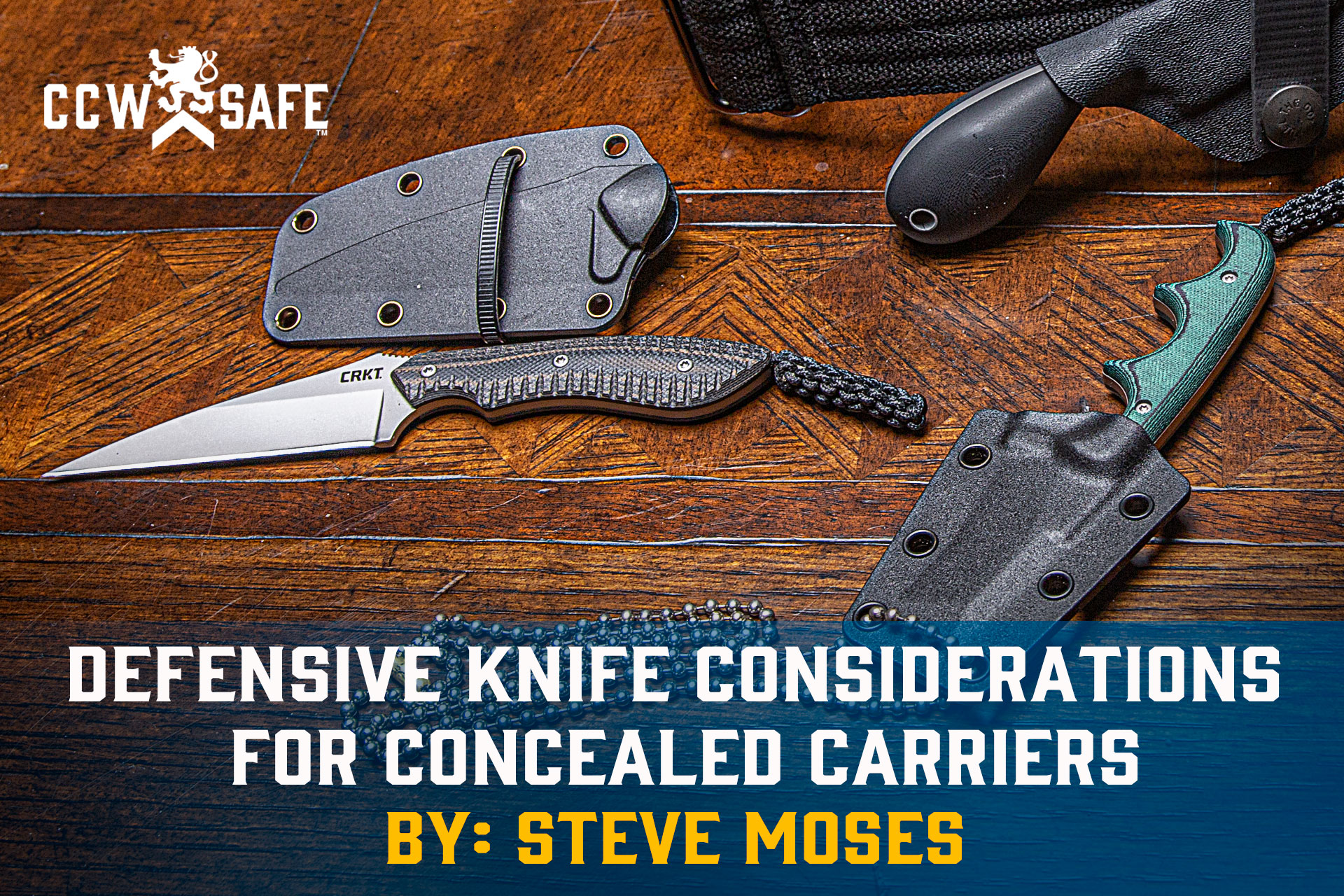
Posted on June 17, 2019
DEFENSIVE KNIFE CONSIDERATIONS FOR CONCEALED CARRIERS
Defensive Knife Considerations For Concealed Carriers
The objective of all concealed carriers should be to survive any potential lethal force encounter with as little damage as possible, and without ending up becoming incarcerated or financially devastated. In order to accomplish this, the concealed carrier might best be served by being knowledgeable, skilled, and armed with appropriate tools. It is my opinion that a small fixed-blade knife (“SFBK”) should have a prominent spot on the list of appropriate tools. In no way does the SFBK replace the defensive handgun, but if forced to defend myself against an attacker or attackers that pose a legitimate threat to life and limb, I want to have on my person the most effective tools possible. There are situations in which the SFBK is the defensive tool of choice, such as:
- I fear for my life while being forced to grapple with a person with obvious superior physical strength or fighting skills, and any attempt by me to deploy the handgun may result in the same being stripped from and used against me. This is almost always the case if I end up on my back with my attacker on top, or my attacker is grasping my dominant arm if I am trying to draw my handgun.
- A similar grappling situation as above, but involving multiple attackers.
- For reasons beyond my control, I am prohibited from having my handgun on my person.
A SFBK carried near the centerline of the body is an effective force multiplier in such situations. It is difficult to access and deploy a folding knife while grappling, especially if the attacker is throwing punches at the head, any of which can concuss or knock me out. Most persons allow their elbow to flare away from the body while reaching for and then opening a folding knife, which makes it easier for the attacker to not only observe the action but seize and isolate the weapon-bearing arm. My take on centerline carry is that the SFBK should be carried on the belt or waistline close to the center of the body, and on the opposite side of the holster. Done properly, the SFBK should then be accessible with either hand.
Other carry methods, while not as desirable as belt or waistband carry, are neck carry and bra carry. Neck carry is best accomplished using a breakable chain, and bra carry is done by securing the sheath to the band between the cups so that the SFBK is carried tip-up and handle down. Palisade Training Group, LLC’s instructor Julie Thomas uses a small bungee cord to accomplish this. I would be the first to say that carrying in either of these methods is something that the concealed carrier would probably need to get accustomed to, and both require some time spent on practicing clearing the covering garment and grasping the handle before such action becomes second-nature.
In terms of targeting, my objective is to stop the threat using only the appropriate force necessary. In many instances, simple thrusts directed at the hands, face and meaty part of the arms and legs will tip the scales into the favor of the defender. Slashes directed at the face can be effective, also. Some persons will continue to fight after sustaining such damage, and it is possible that only serious bodily injury or death will stop the assault. The major arteries in the neck, armpits, and groin area might be the target of choice in those situations. Concealed carriers should be aware that an attacker sustaining such an injury may still be capable of continuing their assault for several minutes until blood loss causes a cessation of such action.
The concealed carrier should take into consideration that knives with names like “Soul-Taker” and “Serpent Breath” may be frowned upon by the District Attorney or juries. Some people are also concerned about the perceptions of others when it comes to using a knife or other cutting instrument for self-defense. However, I frown upon the idea that I might end up seriously injured or killed by another, and if forced to use a knife in order to extricate myself from a situation in which nothing else would have sufficed, I am willing to face the real or imagined consequences.
 |
Steve MosesSteve is a long-time defensive weapons instructor based out of Texas who has trained hundreds of men and women of all ages for more than two decades on how to better prepare to defend themselves and their loved ones. Steve has completed over 80 private-sector and law enforcement-only defensive weapons and tactics classes, and has trained civilian and law-enforcement officers in six states. Moses is a reserve deputy, former member of a multi-precinct Special Response Team, competitive shooter, and martial artist. Steve has written numerous articles for SWAT Magazine and other publications. Steve is a licensed Texas Level 4 Personal Security Officer and Instructor who was Shift Lead on a mega-church security detail for seven years, and has provided close protection for several former foreign Heads of State. He is currently an instructor at Relson Gracie Jiu Jitsu/Krav Maga in Tyler, Texas and Director of Training for Palisade Training Group (www.ptgtrainingllc.com). |